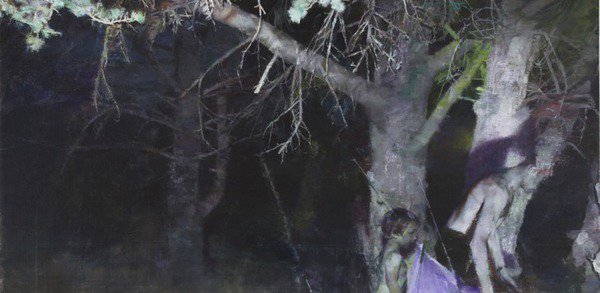How to Tell the Future
dal 16/1/2013 al 1/3/2013
Segnalato da
16/1/2013
How to Tell the Future
Haunch of Venison, New York
From the Past. Works by Yang Jiechang, Justin Mortimer, Patricia Piccinini, Eve Sussman and Joana Vasconcelos. This group show examines the work of 5 artists who suggest the trajectory of humanity not as a continuous advancement, but as an endless return to a base nature.

With Yang Jiechang, Justin Mortimer, Patricia Piccinini, Eve Sussman and Joana Vasconcelos
Haunch of Venison is pleased to present How to Tell the Future from the Past, an exhibition with works by Yang Jiechang, Justin Mortimer, Patricia Piccinini, Eve Sussman and Joana Vasconcelos, on view from January 17th to March 2nd with an opening reception on January 17th from 6 to 8pm. This group show examines the work of five artists who suggest the trajectory of humanity not as a continuous advancement, but as an endless return to a base nature.
Across painting, sculpture and video, the exhibiting artists present individuals as resourceful and sophisticated, yet incapable of fundamentally bettering themselves. The belief in an overarching human narrative destined for a promised goal has in the terms of postmodernity been understood as a fallacy. In spite of this, the desire for moral and intellectual improvement remains central to the idea of advanced society. This paradox is encapsulated in Freud's essay "Civilization and its Discontents," in which he characterizes civilization as "a tool we've created to protect ourselves from unhappiness, and yet, because it denies our most primitive instincts, it is the largest source of our unhappiness."
How to Tell the Future from the Past uses time as the vehicle from which to analyze the dubiousness of humanity's achievements. In the title work, Eve Sussman presents a three-channel video shot during a 72-hour train journey across the steppes of Central Asia. The train makes its way from barren to built-up environments, but the video plays simultaneously backwards and forwards across the three screens, undermining attempts to read logic into the evidence of human influence on the landscape. Similarly, Yang Jiechang merges the ancient and conservative tradition of Chinese ink drawing with shocking, contemporary themes while British painter Justin Mortimer creates contemporary history paintings using a conflicting range of source imagery taken from medical and war journals, the Internet and his own photographs.
Patricia Piccinini and Joana Vasconcelos both exhibit man-made materials and unnatural forms to suggest the unwieldy relationship between who we are and what we want. Piccinini examines humans' complex relationship with technology. Her hyperrealist sculptures of hybrid animals and artificial creatures appear both primitive and highly advanced and provoke anxiety and allure. Vasconcelos incorporates everyday objects and textiles in readymades, which explore the role of traditional customs within a mechanized and technologically-advanced society.
Yang Jiechang (b. 1956) was born in Foshan, Southern China, and lives and works in Paris and Heidelberg, Germany. Jiechang has exhibited at significant museums and institutions around the world including a 2008 solo show at the Shanghai Duolun Museum of Modern Art and a number of groups shows at the Stedelijk Museum voor Actuele Kunst, Belgium; the Artsonje Museum, Gyeongju Bomun, South Korea; Tampere Art Museum, Tampere, Finland; and Macau Museum of Art, China, among others.
Justin Mortimer (b. 1970) is a British painter who lives and works in London. He received the National Portrait Gallery's prestigious BP Portrait Award in 1991. His work is included in various prestigious museums and private collections including the National Portrait Gallery, London; the National Portrait Gallery, Canada; the Royal Collection; and the Flash Art Museum of Contemporary Art, Italy, among others.
Patricia Piccinini (b. 1965) was born in Sierra Leone and currently lives and works in Australia. She has been the subject of a number of solo exhibitions including the Hara Museum, Japan; Tasmanian Museum and Art Gallery, Australia; Frye Art Museum, USA; and the Museum of Contemporary Art, Australia. Select group exhibitions include shows at the Victoria & Albert Museum, London; Brooklyn Museum, New York; Museum of Modern Art, Australia; Georg Kolbe Museum, Berlin, Germany; and Museum of Modern Art, Tokyo; amongst many others.
Eve Sussman (b. 1961) was born in England and currently lives and works in New York. Sussman continuously explores various artistic techniques such as film, video, installation, sculpture, and photography. She has gained worldwide recognition for her film The Rape of the Sabine Women, exhibited in a significant number of important galleries and museums. Her work has been exhibited internationally at various major museums and institutions such as the Whitney Museum of American Art, New York; Reina Sofia, Madrid; and the National Gallery, London, amongst others.
Joana Vasconcelos (b. 1971) was born in Paris and is currently based in Lisbon. The artist came to the public's attention for her display at the 2005 Venice Biennale that greeted visitors to the Arsenale. Her work is included in prestigious public and private collections, and most recently she exhibited at Château de Versailles in 2012. Vasconcelos has been selected to represent Portugal at the 2013 Venice Biennale.
Press Contact: Prentice Art Communications, T 212 228 4048 / Bettina@PrenticeArt.com / Shannon@PrenticeArt.com
Opening reception: January 17, from 6–8pm
Haunch of Venison
550 West 21st Street New York



